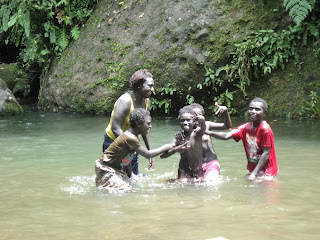In the early 1980s, the again, waiteds in tears for another butched Bougainvillean boxer, John Aba from Rorovana who was killed while servicing his car in Port Moresby, PNG's capital of criminalism. And much later, came more people killed in the many areas of Papua New Guinea.
At these moments, Bougainvilleans cry in unity, under the raging sun of PNG's rapacious colonisation of this Solomon island of Bougainville.
Thursday, the 23 February 2012, saw a thousand Bougainvilleans on the streets of Buka port, airport and the Hahela Catholic mission. This time, Bougainvilleans were brought home 45 pieces of the tang'get off-cuts (plant) representing the 45 lost Bougainvilleans that perished on the morning of 2 February 2012 off the coast of Huon Peninsula in the ill-fated Rabaul Queen.
Pieces of this useless plant, is what PNG is giving back to the longed subjugated people of Bougainville for the lost of lives to its failing service delivery systems.

PNG's Air Niugini jet delivering tang'get to the Bougainville administration

Bougainville government leaders, having received the parcel of plant, tang'get proceed to transport

Procession to Hahela Catholic Mission for a memorial service
After the Hahela service, the procession was led back into town to the main Buka port where the three Rabaul Shipping vessels are now being kept by the ex-combatants where a wreath ceremony was done in respect for the fallen Bougainvilleans.

Crying Bougainvillean hearts at the Buka wharf

People release their wreaths for their loved ones and country man and woman into the sea of the Buka Passage beside the MV Solomon Queen

Wreaths on the water
The releasing our heart into the water through the symbolism of a wreath, we had least did pacify our minds. But are we to release the three Papua New Guinea's Rabaul Shipping's locked-up ferries?
The man who led drunkards on the 3 February 2012 morning as the news hit the Buka town, David Perakai from the Tumpusiong Valley, says, 'Papua New Guinea and Peter Sharp have to compensate Bougainvilleans, then we talk'.

David Perakai
According to mostly mainland Bougainvilleans, now occupying the three ferries, they won't free the vessels for we have been slaves to PNG since the 1960s. Most obvious option available is the burning and sinking of the ships into the Buka Passsage. So, Peter Sharp, the owner of Rabaul Shipping and monopoly holder of the PNG coastal shipping has serious problems, if not, to save his outdated vessels.












































